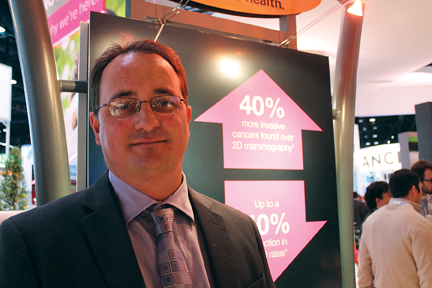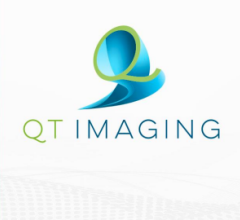
When Radiology Associates of Venice & Englewood (RAVE) replaced its 2D mammography systems with 3D technology last year, it was an unusual move. The practice’s existing 2D systems were still in prime working condition, performing 15,000 mammograms a year. “It was a bold decision to replace working equipment,” acknowledged Mike Kimball, radiology director, “but 3D is the future of breast imaging and is the right way to provide our patients with the best service.”
A private, physician-owned radiology practice, Radiology Associates serves a large Medicare population offering a full spectrum of diagnostic imaging services, including computed tomography (CT), magnetic resonance imaging (MRI), ultrasound, nuclear medicine, positron emission tomography (PET), outpatient interventional radiology, mammography, breast MRI and breast MRI biopsy. The practice has 11 board certified radiologists, eight of whom are Mammography Quality Standards Act (MQSA) certified readers, and five technologists who specialize in breast imaging. They perform a mammography exam every 15 minutes. “We transitioned to 3D because it is our job as radiologists to do what is best for our patients,” explained radiologist Gary Wright, M.D.
Charles Savoca, M.D., former president of RAVE, explained that as owners the radiologists at RAVE have a unique opportunity to invest in the technology that is best for their patients and provides a professionally rewarding experience for themselves. “We stay abreast of new technology, and we were early adopters of digital mammography,” stated Savoca. “We had perfectly functional digital mammography systems; but, we knew 3D was on the horizon, so we watched it to be sure it was best for our patients.”
Defining the Value of 3D Mammography
“When I saw 3D, I thought it was remarkable; similar to the transition from analog to digital mammography,” added Kimball. Initially, not all partners were convinced 3D mammography was right for the practice. “When the partners considered the capital expense, longer reading times and the need for fewer diagnostic tests, some radiologists questioned the added benefit of the technology,” explained Kimball. “They wanted to see results, and when we saw the images from the Hologic 3D Mammography system, everyone was convinced. Even the 2D images on the Hologic system were of higher quality than the images from our existing 2D system.”
Almost immediately, the staff found cancers with the 3D system they could not see on the 2D images. “I was skeptical, but 3D is a real improvement — not hype,” stated Wright. “It has exceeded my expectations. 3D allows you to look at something and tell if it is a summation artifact or not. We can find architectural distortions and spiculated densities not visible with 2D because they are hidden by dense breast tissue. Being able to identify whether a lesion is cancer or not is a huge benefit for our patients.”
Radiologist Eugenio Erquiaga, M.D., agreed. “I have seen as many as five or six tumors in just three months with 3D that weren’t seen on 2D. I recently had a case with suspicious calcifications and was able to give the patient an immediate diagnosis with the 3D images. There was no need to call the patient back for additional views.”
A Better Test for Patients Drives Increase in Demand
Previously, the practice used to leave open slots in its schedule for diagnostic exams. “Callbacks create work for technologists and scheduling assistants; the diagnostic exam takes longer, and the patients are very stressed,” explained Erquiaga. “It’s better for patients if we don’t have to call them back unnecessarily. Since implementing 3D our recall rate has dropped dramatically, and we can confidently fill slots previously held for diagnostic imaging with screening exams, so our schedule remains full.”
The practice began offering evening and Saturday appointments in anticipation of an increase in demand for the 3D exams, and volume is going up. “3D technology is a big differentiator for RAVE,” noted Erquiaga. “When we show 3D to referring physicians, we see an overnight increase in referrals.” Technologist Karen Naaman sees patients coming to the practice because of the 3D exam. “When they come into the exam room, they ask if this is the 3D system,” stated Naaman. “They want to know they are getting the best exam. In fact, we have patients who had 2D exams at other facilities and now are coming to us because we have 3D.”
“3D is good medicine,” concluded Savoca. “We expect to see a return on investment through higher volume, but that is not the issue. The issue is providing good, high-quality medicine.”
“3D mammography improves patient care,” added Kimball. “We have seen a big difference in the quality of exams and the outcomes with 3D. Early detection helps with treatment plans and makes the patient’s quality of life much better.”
Case study supplied by Hologic Inc.
The views and opinions expressed herein are those of Radiology Associates of Venice & Englewood and are not necessarily those of Hologic. This information is intended for medical professionals in the U.S. and other markets and is not intended as a product solicitation or promotion where such activities are prohibited. Because Hologic materials are distributed through websites, eBroadcasts and tradeshows, it is not always possible to control where such materials appear. For specific information on what products are available for sale in a particular country, please contact your local Hologic representative or write to [email protected].
Hologic is a registered trademark of Hologic and/or its subsidiaries in the U.S. and/or other countries.


 December 16, 2025
December 16, 2025 








